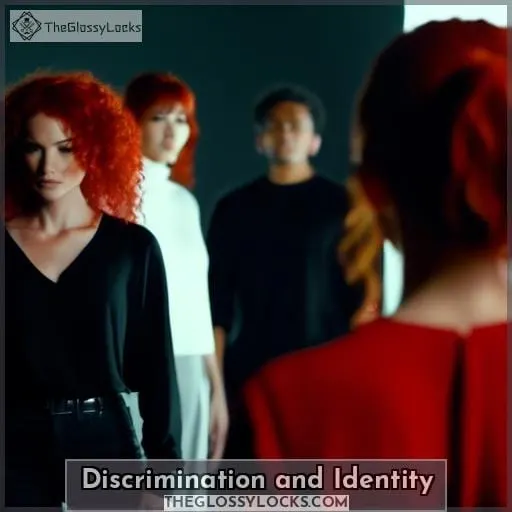This site is supported by our readers. We may earn a commission, at no cost to you, if you purchase through links.
 Diving into the fiery depths of language and culture, you’ve likely pondered why redheads are deemed ginger. This term, rich in history and layered with meaning, has woven itself into the fabric of our linguistic tapestry, sparking curiosity and, at times, controversy.
Diving into the fiery depths of language and culture, you’ve likely pondered why redheads are deemed ginger. This term, rich in history and layered with meaning, has woven itself into the fabric of our linguistic tapestry, sparking curiosity and, at times, controversy.
As we unravel the etymology of ginger, explore its cultural impact, and delve into the experiences of discrimination and identity shaping the red-haired community, we invite you on a journey to understand the profound influence of popular culture and the red-haired community’s own perspective on this distinctive moniker.
Join us as we dissect the myths and meanings behind calling redheads ginger, illuminating a path toward understanding, belonging, and liberation for those touched by this vibrant hue.
Redheads are called ginger due to associations with the red color in ginger-flavored foods and the influence of TV shows like Gilligan’s Island. The term’s exact origin is unknown, with theories ranging from the spicy taste of ginger root to the reddish tinge of ginger-flavored treats.
Table Of Contents
- Etymology of the Term Ginger
- Cultural Impact of the Term
- Discrimination and Identity
- The Impact of Popular Culture
- The Red-Haired Community’s Perspective
- Frequently Asked Questions (FAQs)
- How does the rarity of red hair affect the social dynamics and interactions among redheads themselves?
- Are there any specific health conditions or advantages uniquely associated with redheads beyond the commonly discussed sensitivity to pain and sunlight?
- How do redheads navigate identity and representation in regions or cultures where they are extremely rare or virtually nonexistent?
- What are the historical origins and significance of red hair in non-Western cultures?
- How has the perception of red hair evolved in professional settings, and are there any industries or careers where redheads are particularly celebrated or stigmatized?
- Conclusion
Etymology of the Term Ginger
You might’ve scratched your head wondering why redheads are often d믭 ginger. Well, let’s dive into the spicy history of this term. The word ginger has its roots in the Sanskrit word srngaveram, which combines srngam (horn) and vera (body), likely due to the horn-like shape of the ginger plant’s root.
This ancient term traveled through languages like a game of historical telephone, morphing into Latin zingiberi, then Old French gingibre, and finally settling into the English ginger we know today.
But how did this term leap from describing a spice to branding those with fiery locks? It’s a bit of a head-scratcher, as the ginger root itself isn’t even red. The connection might stem from the reddish hues found in ginger-flavored treats like gingerbread or gingersnap cookies, which share a similar color to many a redhead’s mane.
So, next time you spot a redhead, remember that the term ginger is more than just a nickname; it’s a linguistic journey from ancient times to the present, with a dash of culinary color thrown in for good measure.
Cultural Impact of the Term
Having explored the origins of the term ginger, let’s delve into its cultural impact. You’ve likely noticed how the term has woven itself into the fabric of society, sometimes with a light-hearted nudge, other times with a sting.
- Cultural Appropriation: The term ginger has been tossed around, often without regard for the historical context or the feelings of those it describes.
- Historical Context: Redheads have been both idolized and stigmatized throughout history, with their fiery locks sparking myths and assumptions.
- Social Stigma: The label has carried a social stigma, with stereotypes painting redheads as hot-tempered or different, which can lead to teasing or outright bullying.
- Self-Identification: For some, ginger is a badge of honor, a part of their identity they embrace with pride, despite—or perhaps because of—the stereotypes.
You see, the term ginger isn’t just a quirky nickname; it’s a loaded word that can affect how redheads navigate their world. It’s like they’re carrying a lantern of history on their heads, illuminating some paths, casting shadows on others.
And while some may wear the term like a crown, others feel the weight of centuries-old biases. It’s a complex dance of self-identification and societal perception, where every step is scrutinized. So, when you hear ginger, remember it’s more than just a spice or a color—it’s a story, a struggle, and for some, a source of pride.
Discrimination and Identity
As we delve deeper into the cultural impact of being called ginger, it’s crucial to explore the intertwined issues of discrimination and identity that redheads navigate. Historical context reveals that redheads have often been the butt of stereotypes, leading to a unique form of discrimination.
This isn’t just about a few jokes; it’s about how societal expectations shape personal experiences, influencing how redheads see themselves and are seen by others.
You’ve likely heard the myths: redheads have fiery tempers or are somehow more exotic. These stereotypes don’t just float in the ether; they impact lives, contributing to a sense of otherness. But here’s the twist: amidst the challenges, there’s a powerful narrative of self-acceptance emerging.
Many redheads are flipping the script, embracing their unique hair color as a badge of honor, a core part of their identity that sets them apart in a sea of societal norms.
This journey towards self-acceptance isn’t just about liking what you see in the mirror. It’s a bold statement against societal expectations, a declaration that being different isn’t just okay—it’s something to celebrate.
So, while the road might be peppered with outdated jokes and stereotypes, the redhead community is redefining what it means to be ginger, turning a potential stigma into a source of strength and identity.
The Impact of Popular Culture
You’ve seen them, those fiery-haired characters that light up the screen and steal the show. But have you ever stopped to wonder why redheads, affectionately d믭 ‘gingers,’ have such a magnetic pull in popular culture? It’s not just about the rarity of their crimson locks; it’s the stories they tell and the stereotypes they shatter.
Take a stroll through the annals of media portrayals, and you’ll find a mixed bag of ginger representation. From the feisty sidekicks to the soulful protagonists, redheads have been cast in roles that both embrace and challenge societal perceptions.
Remember the days when red-haired stereotypes painted them as hot-tempered or the butt of a joke? Well, those days are getting a makeover.
Popular culture has been a double-edged sword for gingers. On one hand, it’s amplified some laughable clichés—think of the nerdy, freckle-faced kid with a temper to match his hair. But on the flip side, it’s given us characters that resonate with depth and humanity, breaking free from the mold of cultural appropriations.
So, next time you see a ginger gracing your favorite show or movie, take a moment to appreciate the cultural shift. They’re not just there to add a splash of color; they’re redefining what it means to be a redhead in a world that’s finally ready to embrace the full spectrum of ginger awesomeness.
The Red-Haired Community’s Perspective
As you’ve seen, redheads often find themselves in the spotlight, sometimes for reasons that are less than flattering. You’ve heard the jokes, the stereotypes, and the myths that swirl around those with fiery locks.
You’ve seen redheads portrayed as everything from superheroes to the butt of the joke in media, but behind the scenes, there’s a rich tapestry of lived experiences. For many redheads, their hair is a badge of honor, a unique trait that sets them apart in a sea of blondes and brunettes.
It’s not just about the color; it’s about the identity that comes with it. Self-identification as a ‘ginger’ can be a source of pride, despite the historical context that hasn’t always been kind.
Red hair’s cultural significance is complex, and redheads in the media have both helped and hindered the public’s understanding. But let’s cut to the chase: redheads have heard it all, from Does the carpet match the drapes? to being asked if they’ve a fiery temper to match their hair.
Yet, they often take these comments with a grain of salt, sometimes even with a chuckle, because they know that what makes them different also makes them extraordinary.
So, while the world may have its preconceptions, redheads continue to embrace their unique hue, turning what was once a source of mockery into a symbol of individuality and strength. After all, in a world where everyone is trying to fit in, standing out can be a superpower.
Frequently Asked Questions (FAQs)
How does the rarity of red hair affect the social dynamics and interactions among redheads themselves?
The rarity of red hair fosters a unique camaraderie among redheads. This uncommon trait bonds them in a world of fiery locks, shaping their social dynamics with a blend of exclusivity and shared experiences.
Are there any specific health conditions or advantages uniquely associated with redheads beyond the commonly discussed sensitivity to pain and sunlight?
You’ve got a unique mix in your genes that’s more than just a vibrant hair color.
Beyond the well-known sensitivity to sunlight and pain, redheads can produce their own vitamin D in low light. They mightn’t need as much pain medication due to a hormone similar to endorphins.
So, while you’re rocking that rare hair color, your body’s playing by its own set of rules!
How do redheads navigate identity and representation in regions or cultures where they are extremely rare or virtually nonexistent?
With less than 2% of the world’s population sporting red locks, you stand out in a crowd, don’t you? Embracing your fiery mane in places where it’s as rare as a four-leaf clover can be a badge of honor.
You’re a walking conversation starter, a splash of color in a monochrome scene. Sure, you might field the odd myth about your temper or soul, but remember, you’re not just a rarity; you’re a conversation piece, a living artwork.
Keep your chin up and let that red flag fly high!
What are the historical origins and significance of red hair in non-Western cultures?
In non-Western cultures, red hair has been a symbol of distinction, often linked to nobility or supernatural traits.
For instance, in ancient Egypt, red-haired animals and people were associated with the god Set, and several pharaohs sported red hair.
In Asia, red hair appears among diverse groups, from Afghan to Mongolian peoples, hinting at a rich tapestry of genetic and migratory histories.
This rare trait, weaving through history and geography, highlights humanity’s complex interplay with genetics and culture.
How has the perception of red hair evolved in professional settings, and are there any industries or careers where redheads are particularly celebrated or stigmatized?
In professional settings, red hair’s perception has softened, yet stereotypes linger.
Redheads aren’t universally celebrated or stigmatized, but biases can color workplace dynamics, subtly influencing career trajectories.
Conclusion
As the saying goes, A rose by any other name would smell as sweet, and so it is with redheads, regardless of whether they’re called ginger or not.
Your journey through the etymology and cultural significance of the term has shown that while the origins may be as mixed as the shades of red hair, the impact is clear.
You’ve seen how the term ginger can be both a badge of pride and a source of discrimination. Remember, embracing the term ginger is a personal choice, and its use should always be respectful.








